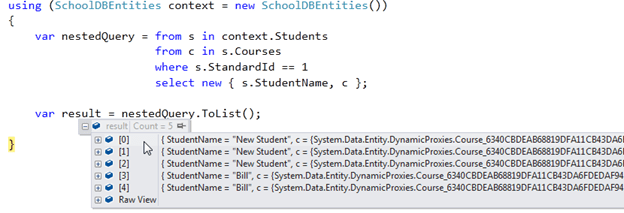Entity Framework Tutorial Basics(16):Linq-to-Entities Projection Queries
2016-07-07 10:06
519 查看
Linq-to-Entities Projection Queries:
Here, you will learn how to write LINQ-to-Entities queries and get the result entities. Visit LINQ Tutorials to learn LINQ step by step.Projection is a process of selecting data in a different shape rather than a specific entity being queried. There are many ways of projection. We will now see some projection styling:
First/FirstOrDefault:
If you want to get a single student object, when there are many students, whose name is "Student1" in the database, then use First or FirstOrDefault, as shown below:using (var ctx = new SchoolDBEntities())
{
var student = (from s in ctx.Students
where s.StudentName == "Student1"
select s).FirstOrDefault<Student>();
}The above query will result in the following database query:
SELECT TOP (1) [Extent1].[StudentID] AS [StudentID], [Extent1].[StudentName] AS [StudentName], [Extent1].[StandardId] AS [StandardId] FROM [dbo].[Student] AS [Extent1] WHERE 'Student1' = [Extent1].[StudentName]
The difference between First and FirstOrDefault is that First() will throw an exception if there is no result data for the supplied criteria whereas FirstOrDefault() returns default value (null) if there is no result data.
Single/SingleOrDefault:
You can also use Single or SingleOrDefault to get a single student object as shown below:using (var ctx = new SchoolDBEntities())
{
var student = (from s in context.Students
where s.StudentID == 1
select s).SingleOrDefault<Student>();
}The above query would execute the following database query:
SELECT TOP (2) [Extent1].[StudentID] AS [StudentID], [Extent1].[StudentName] AS [StudentName], [Extent1].[StandardId] AS [StandardId] FROM [dbo].[Student] AS [Extent1] WHERE 1 = [Extent1].[StudentID] go
Single or SingleOrDefault will throw an exception, if the result contains more than one element. Use Single or SingleOrDefault where you are sure that the result would contain only one element. If the result has multiple elements then there must be some problem.
ToList:
If you want to list all the students whose name is 'Student1' (provided there are many students has same name) then use ToList():using (var ctx = new SchoolDBEntities())
{
var studentList = (from s in ctx.Students
where s.StudentName == "Student1"
select s).ToList<Student>();
}The above query would result in the following database query:
SELECT [Extent1].[StudentID] AS [StudentID], [Extent1].[StudentName] AS [StudentName], [Extent1].[StandardId] AS [StandardId] FROM [dbo].[Student] AS [Extent1] WHERE 'Student1' = [Extent1].[StudentName] go
GroupBy:
If you want to group students by standardId, then use groupby:using (var ctx = new SchoolDBEntities())
{
var students = from s in ctx.Students
group s by s.StandardId into studentsByStandard
select studentsByStandard;
}The above query would execute the following database query:
SELECT [Project2].[C1] AS [C1], [Project2].[StandardId] AS [StandardId], [Project2].[C2] AS [C2], [Project2].[StudentID] AS [StudentID], [Project2].[StudentName] AS [StudentName], [Project2].[StandardId1] AS [StandardId1] FROM ( SELECT [Distinct1].[StandardId] AS [StandardId], 1 AS [C1], [Extent2].[StudentID] AS [StudentID], [Extent2].[StudentName] AS [StudentName], [Extent2].[StandardId] AS [StandardId1], CASE WHEN ([Extent2].[StudentID] IS NULL) THEN CAST(NULL AS int) ELSE 1 END AS [C2] FROM (SELECT DISTINCT [Extent1].[StandardId] AS [StandardId] FROM [dbo].[Student] AS [Extent1] ) AS [Distinct1] LEFT OUTER JOIN [dbo].[Student] AS [Extent2] ON ([Distinct1].[StandardId] = [Extent2].[StandardId]) OR (([Distinct1].[StandardId] IS NULL) AND ([Extent2].[StandardId] IS NULL)) ) AS [Project2] ORDER BY [Project2].[StandardId] ASC, [Project2].[C2] ASC go
OrderBy:
If you want to get the list of students sorted by StudentName, then use OrderBy:using (var ctx = new SchoolDBEntities())
{
var student1 = from s in ctx.Students
orderby s.StudentName ascending
select s;
}The above query would execute the following database query:
SELECT [Extent1].[StudentID] AS [StudentID], [Extent1].[StudentName] AS [StudentName], [Extent1].[StandardId] AS [StandardId] FROM [dbo].[Student] AS [Extent1] ORDER BY [Extent1].[StudentName] ASC go
Anonymous Class result:
If you want to get only StudentName, StandardName and list of Courses for that student in a single object, then write the following projection:using (var ctx = new SchoolDBEntities())
{
var projectionResult = from s in ctx.Students
where s.StudentName == "Student1"
select new {
s.StudentName, s.Standard.StandardName, s.Courses
};
}The above query would execute the following database query:
SELECT [Extent1].[StudentID] AS [StudentID], [Extent1].[StudentName] AS [StudentName], [Extent2].[City] AS [City] FROM [dbo].[Student] AS [Extent1] LEFT OUTER JOIN [dbo].[StudentAddress] AS [Extent2] ON [Extent1].[StudentID] = [Extent2].[StudentID] WHERE 1 = [Extent1].[StandardId] go
The projectionResult in the above query will be the anonymous type, because there is no class/entity which has these properties. So, the compiler will mark it as anonymous.
Nested queries:
You can also execute nested LINQ to entity queries as shown below:
The nested query shown above will result in an anonymous list with a StudentName and Course object.
SELECT [Extent1].[StudentID] AS [StudentID], [Extent1].[StudentName] AS [StudentName], [Join1].[CourseId1] AS [CourseId], [Join1].[CourseName] AS [CourseName], [Join1].[Location] AS [Location], [Join1].[TeacherId] AS [TeacherId] FROM [dbo].[Student] AS [Extent1] INNER JOIN (SELECT [Extent2].[StudentId] AS [StudentId], [Extent3].[CourseId] AS [CourseId1], [Extent3].[CourseName] AS [CourseName], [Extent3].[Location] AS [Location], [Extent3].[TeacherId] AS [TeacherId] FROM [dbo].[StudentCourse] AS [Extent2] INNER JOIN [dbo].[Course] AS [Extent3] ON [Extent3].[CourseId] = [Extent2].[CourseId] ) AS [Join1] ON [Extent1].[StudentID] = [Join1].[StudentId] WHERE 1 = [Extent1].[StandardId] go
In this way, you can do a projection of the result, in the way that you would like the data to be.
相关文章推荐
- Entity Framework Tutorial Basics(15):Querying with EDM
- CF 678F Lena and Queries
- iOS App开发中的UIStackView堆叠视图使用教程
- EasyUi常用组件(四)Dialog对话框、创建按钮(Buttons)、创建工具栏(Toolbar)
- 根据UIColor对象,获取对应的RGBA值
- Vue.js
- 使用射线碰撞攻击目标
- android 6.0 healthd vold接收uevent
- APUE 1-9 打印用户ID和组ID
- APUE 1-8 strerror 和 perror
- APUE 1-7 从标准输入读命令并执行
- APUE 1-6打印进程ID
- POWERBUILDER -- PB通过URL下载局域网或者互联网上的图片或者文件
- APUE 1-5用标准I/O将标准输入复制到标准输出
- APUE 1-4用标准将标准输入复制到标准输出
- 这个贴子的内容值得好好学习--实例详解Django的 select_related 和 prefetch_related 函数对 QuerySet 查询的优化
- codeforces 375D Tree and Queries
- Vue.js——基于$.ajax实现数据的跨域增删查改
- Subarray Sum to the given target value
- LintCode_124 Longest Consecutive Sequence
